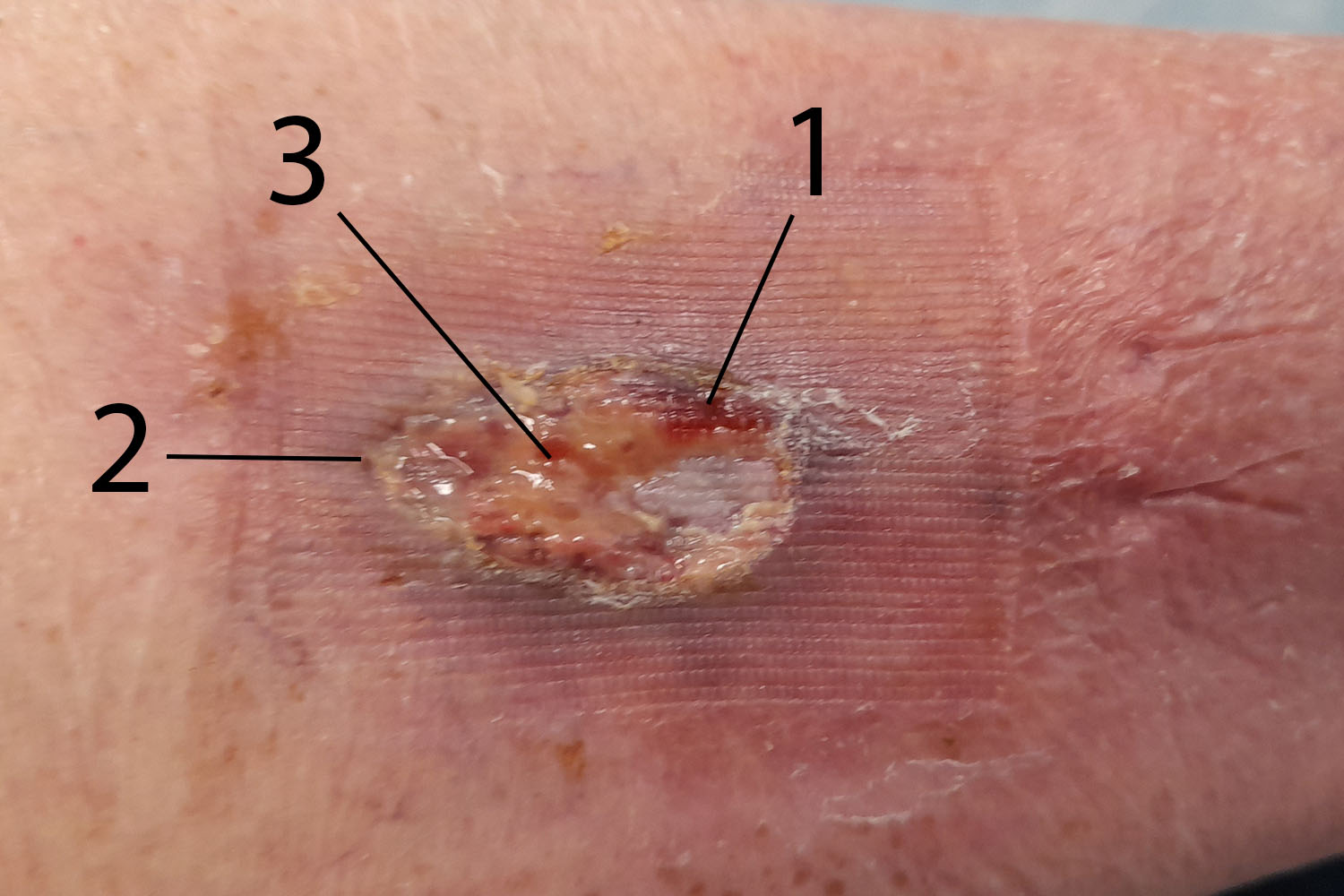After just one week all the problems seen in the first picture are fixed and the wound is on the way to healing.
Leg ulcers
There are two very distinct types of leg ulcer:
Non-healing injury or surgical wound on healthy legs
Often from a knock to the shin, patients can end up in a cycle of going to the NHS for redressings twice a week for months and even years. The dressings typically used will make the wound too wet, especially if honey is used. The dressings put pressure in the wound. The wounds are often cleaned aggressively twice a week. Patients are often told they can get the wound wet in the shower and then have frequent infections. Any of the above could be enough to stop a wound healing.
Using the podiatry wound care technique we can usually heal this type with 3 or 4 appointments. You can find some testimonials from previous patients at the end of this page.
Non-healing wound on an unhealthy leg
It can still start with a knock or it can come on its own but if it has come on its own, thats a sure sign that the leg is unhealthy.
The skin on an unhealthy leg nearly always looks abnormal, it could be related to swelling or a blood circulation issue. The skin can be either sclerotic (hard), red or brown stained, with flaky or silvery skin, sometimes leaking fluid through the skin.
These are much harder to treat, it would take longer and we might not be able to offer anything in addition to what is available from the NHS. That said patients who come usually report increased comfort and they tend to have a decreased number of infections and increased healing, though still slow.
If it started with a knock and isn't healing, don't automatically believe that the leg is at fault. Even if you have had a vascular scan and found some deficiency it could anyway be the case that with a better technique the wound will heal. Most people over 60 have a few varicose veins around their ankles, but that does not make a non-healing injury on a shin a "venous ulcer".
Approximately 90% of cases we have seen have then healed in normal time, proving there was nothing wrong with their legs even though they had usually been told their leg was the cause of non-healing.
There is also an increasing number of patients with very chronic wounds who have been told to treat it themselves as there is a shortage of NHS staff, in which case we're here for you if you need us.
Podiatry for your leg wound?
Your Nurse or GP might not know this but Podiatrists have specialist knowledge for lower limbs up to the hip - not just feet.
The well proven principles that podiatrists use for diabetic foot ulcers work supremely well on other areas of skin too. We use breathable dressings and padding to create an ideal environment for the body to get on with healing the wound. Not too wet and not too dry.
The Podiatry difference
Below is a patient with a post surgery wound after a couple of months of failed NHS treatment, it was getting worse not better.
- 1.The red tissue is called granulation tissue, thats the good stuff new skin is made from. The criss-cross lines are from a gauze dressing being pushed into the wound by a pressure causing dressing, which is damaging the delicate granulation tissue.
-
2. The wound is getting bigger due to being too wet, likely due to honey being applied and the amount of inflammation.
-
3. The wound is covered by slough which will likely be rubbed off twice a week which will damage the granulation tissue and cause the inflammation which can be seen around the wound. Inflammation causes more fluid in the wound leading to further problems for healing.


After 2 weeks

After 3 weeks

After the 3rd week a dressing was applied and left on for as long as possible, the scab came off in its own time leaving a scarred but perfectly healed leg.

Another example
Below is a patient with a small but persistent wound which was getting no better after 18 NHS appointments. The wound is suffering the same problems as the first example: A pressure causing dressing. Overly wet. Overly inflamed.


After 1 week, no more inflammation, correct moisture level, no slough but there is a tough scab to deal with.

As podiatrists can use a scalpel we can very gently remove the scab that would over wise plug the wound.

After 2 weeks, to an experienced eye this scab can be left in place as it is a normal healing scab. Just a pad and simple dressing was applied.

After a few more weeks the delighted patient sent us this photo of a scarred but perfectly healed leg.

What is the cost of private treatment?
Each appointment is £43 plus the cost price of dressings which for a single ulcer over a few weeks could be an additional £15-25 total. Usually 3 to 4 appointments are enough to heal a superficial wound on a healthy leg, so all in £130 to £170. If you cannot afford this please ring to discuss your case as we might still be able to help.
If there are significant underlying health problems or it has become a deep chronic ulcer it will take longer and unfortunately in rare cases there are some ulcers that might not heal without some other intervention such as surgery on your blood circulation. At the initial assessment estimation of these things can be given and it will be clear if the leg is responding well after a few appointments.
Ideally patients should attend to try podiatry before trying compression bandaging which is increasingly being applied to healthy legs in the NHS.





